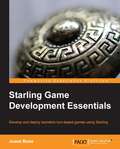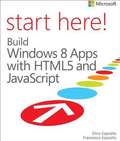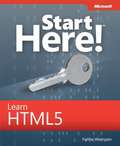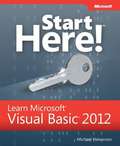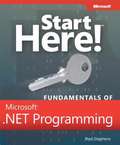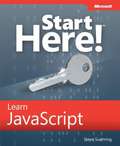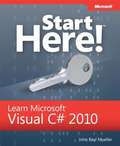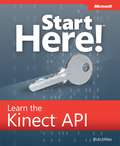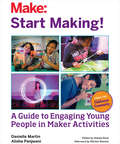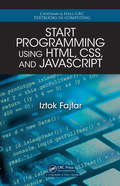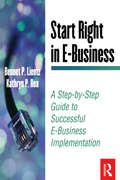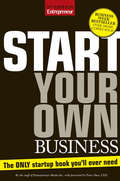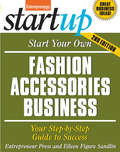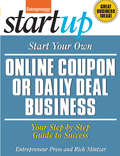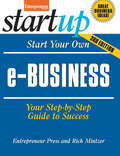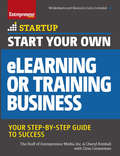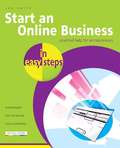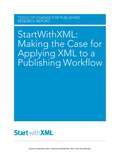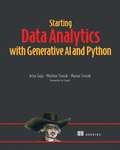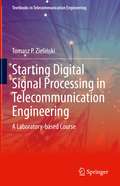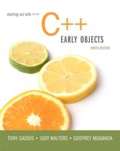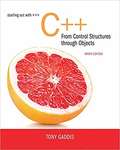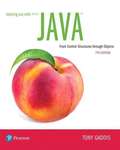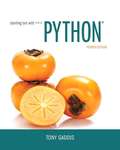- Table View
- List View
Starling Game Development Essentials
by Juwal BoseThis is a practical, project-based guide that will help the reader to build Isometric, turn-based games using Starling.If you are an ActionScript developer and want to create cross-platform games with Starling, this book is for you. The FlagDefense game covers some complex topics in game development which are beneficial even for those who are already creating games with Starling. Prior knowledge of Starling will help, but is not necessary.
Start Here! Build Windows 8 Apps with HTML5 and JavaScript
by Dino Esposito Francesco EspositoReady to learn Windows 8 programming? Start Here!TM Learn the fundamentals of Windows 8 programming--and begin creating apps for desktops, laptops, tablets, and other devices. If you have previous experience with HTML5 and JavaScript--simply start here! This book introduces must-know concepts and getting-started techniques through easy-to-follow explanations, examples, and exercises. Here's where you start learning Windows 8 app development Build on your knowledge of HTML5, CSS, and JavaScript Create photo and media galleries with built-in HTML widgets Interact with the system through live tiles, contracts, and view state detection Store and access data on the local device and via the Internet Access webcam, GPS, and other sensors embedded in the device Create your first programs and publish them to the Windows Store
Start Here!TM Learn HTML5
by Faithe Wempen<p>Learn the fundamentals of programming with HTML5—and begin building your first standards-based web pages from the ground up. If you have absolutely no previous experience, no problem—simply start here! This book introduces must-know concepts and getting-started techniques through easy-to-follow explanations, examples, and exercises.</p>
Start Here!TM Learn Microsoft Visual Basic® 2012
by Michael Halvorson<p>Learn the fundamentals of modern programming with Microsoft® Visual Basic® 2012—and begin building your first Windows 8 apps for the desktop. If you have absolutely no previous experience with Visual Basic, no problem—simply start here! This book introduces must-know concepts and techniques through easy-to-follow explanations, examples, and exercises.</p>
Start Here!™ Fundamentals of Microsoft® .NET Programming
by Rod StephensGrasp the basic concepts that drive all Microsoft® .NET-based languages--and prepare yourself to learn .NET programming. If you have absolutely no previous experience, no problem--simply start here! This ebook provides the foundation for all other .NET programming language books in the Start Here! series. You'll explore programming concepts and techniques with clear explanations, easy-to-follow examples, and exercises. It's the perfect reference for understanding how computer programs work. Delve into object-oriented concepts such as properties, methods, and events Discover what multiprocessing is--and how it's changing computing Examine how programs store data in files, object stores, and databases Explore controls, such as labels, text boxes, menus, and scroll bars Learn how programming environments help you design and run programs Get an extensive glossary of key programming terms e world Get an extensive glossary of key programming terms
Start Here!™ Learn JavaScript
by Steve SuehringReady to learn JavaScript? Start Here! Learn the fundamentals of modern programming with JavaScript--and begin building your first apps for the web. If you have no previous experience with JavaScript, no problem--simply start here! This book introduces must-know concepts and techniques through easy-to-follow explanations, examples, and exercises. Here's where you start learning JavaScript Learn the basics of JavaScript programming Find out how to access browser content from JavaScript Manage images and validate form entries Retrieve data using the JavaScript Object Notation (JSON) Use JavaScript and HTML5 in Windows 8 applications Put it all together by creating your first programs
Start Here!™ Learn Microsoft® Visual C#® 2010
by John Paul MuellerReady to learn programming? Start Here!TM Learn the fundamentals of modern programming with Visual C# 2010--and begin building your first apps for the desktop and web. If you have absolutely no previous experience, no problem--simply start here! This book introduces must-know concepts and techniques through easy-to-follow explanations, examples, and exercises. Here's where you start learning Visual C#Learn how an application performs tasks by tracing its code Query and manipulate application data with LINQ Access web services with REST and SOAP Build simple apps with Windows® Presentation Foundation Explore rich Internet apps with Microsoft Silverlight® Find and fix errors by debugging your applications Put it all together by creating your first programs
Start Here!™ Learn the Kinect™ API
by Rob MilesReady to learn Kinect programming? Start Here!TM Learn the fundamentals of programming with the KinectTM API--and begin building apps that use motion tracking, voice recognition, and more. If you have experience programming with C#--simply start here! This book introduces must-know concepts and techniques through easy-to-follow explanations, examples, and exercises. Here's where you start learning Kinect Build an application to display Kinect video on your PC Have Kinect take photographs when it detects movement Draw on a computer screen by moving your finger in the air Track your body gestures and use them to control a program Make a program that understands your speech and talks back to you Play a part in your own augmented reality game Create an "air piano" using Kinect with a MIDI device
Start Making!: A Guide to Engaging Young People in Maker Activities
by Danielle Martin Alisha Panjwani Natalie RuskStart Making! is a program developed by the Clubhouse Network to engage young people all over the world in Maker-inspired activities. With this guide, you will discover how to plan and coordinate Start Making! projects in your home, school, library, community center, after-school club, or makerspace. You'll learn strategies for engaging young people in creative thinking, developing individual and team projects, and sharing and reflecting on their creations.Each session includes a list of the supplies you'll need, step-by-step instructions for completing the projects, and prompts for stimulating discussion, curiosity, and confidence. These fun do-it-yourself (and do-it-together) projects teach fundamental STEAM concepts -- science, technology, engineering, art, and math -- while introducing young people to the basics of circuitry, design, coding, crafting, and construction. They'll make paper cards and creations that light up, play music using a MaKey MaKey keyboard and Scratch programming, join together to make paintings with light, design and construct 3D sculptures, build a vibrating art-bot that makes drawings, and sew fabric creations with wearable circuits.Dip into the activities once a week, run them as a week-long summer activity, or go through the guide in any way that works for you. By offering your own Start Making! program, you can inspire young people in your community to develop creative ideas, learn new skills, and share their creations.The Clubhouse Network is a global network of community-based centers led by Boston's Museum of Science in collaboration with the MIT Media Lab.
Start Programming Using HTML, CSS, and JavaScript (Chapman & Hall/CRC Textbooks in Computing)
by Iztok FajfarThis text is a manual for undergraduate students in engineering and the natural sciences to discover how computer programming works. Using a dialog format between two students and a professor, the text teaches students how the mainstream web languages HTML, CSS, and JavaScript interact and how to harness their capabilities in practical settings. Each chapter focuses on a specific theme supported by a gradual development of engaging worked examples of live web documents and applications using the three languages.
Start Right in E-Business
by Bennet Lientz Kathryn ReaE-business occurs when a company has established critical business procedures and activities to support e-commerce transactions. Using this definition, e-commerce is part of e-business--a company needs e-commerce to implement e-business. Utilizing e-commerce, however, does not mean that a company has transformed into an e-business. E-business is implemented only when a company changes its internal procedures to take advantage of the e-commerce technologies.Interest in the evolution ("e-volution") of e-commerce into e-business is a growth field. With the early November announcement that GM and Ford were forming online marketplaces for their suppliers, they placed themselves at the center of new e-business ecosystems that will transform their entire way of doing business. Many firms are increasingly discovering opportunities to move away from simply selling products on the Internet to being able to reinvent their conventional supply chains (as in the auto makers' case) and to being able to offer custom-built products (as Dell Computers does now).
Start Your Own Business
by Inc The Staff of Entrepreneur MediaTap into more than 30 years of small business expertise as you embark on the most game-changing journey of your life - your new business. This unmatched guide - the best-selling business startup book of all time - offers critical startup essentials and a current, comprehensive view of what it takes to survive the crucial first three years, giving your exactly what you need to survive and succeed. Plus, you'll get advice and insight from experts and practicing entrepreneurs, all offering common-sense approaches and solutions to a wide range of challenges. Pin point your target market Uncover creative financing for startup and growth Use online resources to streamline your business plan Learn the secrets of successful marketing Discover digital and social media tools and how to use them Take advantage of hundreds of resources Receive vital forms, worksheets and checklists From startup to retirement, millions of entrepreneurs and small business owners have trusted Entrepreneur to point them in the right direction. We'll teach you the secrets of the winners, and give you exactly what you need to lay the groundwork for success.
Start Your Own Fashion Accessories Business
by Entrepreneur Press Eileen Figure SandlinBasic updating of resources and interviews with successful owners in the fashion accessories business. Trendy entrepreneurs learn how to create and sell their own accessories, buy wholesale accessories for resale or establish their own online or traditional store. Our experts take them step by step from creating a business plan, to setting up a home workshop and office, exploring the market, managing finances, publicizing and advertising the business and much more. Industry professionals and practicing home-based business owners provide unique insights, tips and tricks to ensure success. This step-by-step guide gives aspiring entrepreneurs everything they need to know to turn their passion for fashion into a successful business.
Start Your Own Online Coupon or Daily Deal Business
by Rich Mintzer Entrepreneur MagazineUnlike old-school "design your own coupon book" titles, this book moves straight into computer technology and proceeds to the latest trend in couponing . . . apps, which provide deals to mobile users in any location. Many daily deal businesses do not work to enhance the experience for their merchants. Readers, however, can learn how to do so. Experts in the industry are also included such as Marc Horne, co-creator of Daily Deal Builder, who discusses what it takes to build a daily deal site, David Teichner, CEO of Yowza!! who brought deal apps to iPhones and several business owners who have tried their luck at running daily deal. They discuss what they have learned from the process.Currently there are few, if any, other books on how to start a daily deal business and the coupon books focus on how to use coupons and even on extreme couponing, but not on running an online coupon business. This is a unique title which provides those who enjoy offering deals and discounts to get started in an industry that is still growing.
Start Your Own e-Business
by Rich Mintzer Entrepreneur MagazineWith retail e-commerce sales topping $263.3 billion in 2013,and millions of people now flourishing as internet entrepreneurs, the web is the place for new businesses to be. This guide makes tapping into highly lucrative markets with an easy-to-start, inexpensive internet business easier than ever. Readers can use the successful strategies and extensive step-by-step process outlined in this book to turn their dream of entrepreneurship into a lucrative, online reality. With information on everything from choosing a domain and building a site to search engine optimization and cashing in on affiliate programs, this indispensable guide will become every "netpreneur's" business-building bible.
Start Your Own eLearning or Training Business
by The Staff of Entrepreneur Media Ciree LinsenmannPossibly credited to advancements in technology or learning behaviors, or a rise in focus on personal development, the education and training industry is steadily growing, creating a demand for eager entrepreneurs. Exploring varied opportunities aspiring business owners will be given business ideas, teaching and training methods, and an overview of essential tools. A range of industry examples will be given for: Accreditation, certifications, and credit Adding training onto an existing business as side income How to sell media/training tools How much to charge clients Start up costs Software types used The legal obligations around taxes, business registration, working from home, and content confidentiality Growth planning and writing a business planRelevant and fun call-outs, tip boxes, industry stats, an index, and a rich appendix and glossary will be provided. Appendix will offer resources in: Continued learning and rounded training for trainers Industry organizations and trade groups Books and eBooks Videos Software Websites Successful online trainers and online education institutions Consultants Certification organizationsTeaching methods and tools will cover: Videos eBooks Interactive software types College sponsored staff training for college instructors Hardware, camera, video, sound equipment Online group forums Online events Choosing the right presentation style and linking to appropriate social media sites Networking presentations
Start an Online Business in Easy Steps
by Jon SmithStart an Online Business in Easy Steps is an invaluable business guide as well as a practical guide to creating a successful online business.It starts by asking the reader to clearly think through why he/she wants to start a business; whether an online business is the right approach for the business and who the business is aimed at. It even suggests ways of raising finance for starting the business.Then, the guide covers the practical aspects: setting up the website, getting a domain name, e-commerce, and accounting and running the online business. It explains how to manage website as well as the supply chain for both types of businesses, where the reader is supplying physical products or where he/she is selling downloadable digitized products and subscriptions.Finally, the author uses his invaluable experience to guide the reader through marketing the business and online customer relations. He uses his insight to enlighten the reader to consider different revenue streams such as partnering with other websites as well as earning advertising revenue.A practical guide to inspire entrepreneurs!
StartWithXML: Making the Case for Applying XML to a Publishing Workflow
by Mike Shatzkin Brian O'Leary Laura Dawson Ted HillPublishers face a "Copernican change." Until recently, the book was"the sun" of a publishing solar system, and all other opportunitieswere subsidiary rights revolving as planets around it. Now, theintellectual property is the sun, and the book becomes just one of theorbiting opportunities. To be successful in the 21st centuryenvironment, publishers must produce agile content: content that canbe rendered in different forms without great additional expense. XMLprovides both a path to agility and opens opportunities for currentand future digital content revenue streams. StartWithXML is an industry-wide project to understand and spread theknowledge publishers need to move forward with XML. It's about thebusiness issues driving the "why" of XML and the technical andorganizational issues, strategies, and tactics underlying the "how" ofgetting started. This research report takes a pragmatic look at XMLworkflows, addressing questions such as:Where am I and where do I want to end up?How much benefit do I want to obtain from content reuse and repurposing?How much work do I want to do myself?How much time and money will this take?What can I do internally to increase my chances of success?
Starting Data Analytics with Generative AI and Python
by Marian Siwiak Artur Guja Marlena SiwiakAccelerate your mastery of data analytics with the power of ChatGPT.Whether you&’re brand new to data analysis or an experienced pro looking to do more work, faster, Starting Data Analytics with Generative AI and Python is here to help simplify and speed up your data analysis! Written by a pair of world-class data scientists and an experienced risk manager, the book concentrates on the practical analytics tasks you'll do every day. Inside Starting Data Analytics with Generative AI and Python you&’ll learn how to: • Write great prompts for ChatGPT • Perform end-to-end descriptive analytics • Set up an AI-friendly data analytics environment • Evaluate the quality of your data • Develop a strategic analysis plan • Generate code to analyze non-text data • Explore text data directly with ChatGPT • Prepare reliable reports In Starting Data Analytics with Generative AI and Python you&’ll learn how to improve your coding efficiency, generate new analytical approaches, and fine-tune data pipelines—all assisted by AI tools like ChatGPT. For each step in the data process, you&’ll discover how ChatGPT can implement data techniques from simple plain-English prompts. Plus, you&’ll develop a vital intuition about the risks and errors that still come with these tools. About the technology If you have basic knowledge of data analysis, this book will show you how to use ChatGPT to accelerate your essential data analytics work. This speed-up can be amazing: the authors report needing one third or even one quarter the time they needed before. About the book You&’ll find reliable and practical advice that works on the job. Improve problem exploration, generate new analytical approaches, and fine-tune your data pipelines—all while developing an intuition about the risks and errors that still come with AI tools. In the end, you&’ll be able to do significantly more work, do it faster, and get better results, without breaking a sweat. Assuming only that you know the foundations, this friendly book guides you through the entire analysis process—from gathering and preparing raw data, data cleaning, generating code-based solutions, selecting statistical tools, and finally creating effective data presentations. With clearly-explained prompts to extract, interpret, and present data, it will raise your skills to a whole different level. What's inside • Write great prompts for ChatGPT • Perform end-to-end descriptive analytics • Set up an AI-friendly data analytics environment • Evaluate the quality of your data • Develop a strategic analysis plan • Generate code to analyze non-text data • Explore text data directly with ChatGPT • Prepare reliable reports About the author Authors Artur Guja, Dr. Marlena Siwiak, and Dr. Marian Siwiak are experienced data scientists with backgrounds in business, scientific research, and finance. The technical editor on this book was Mike Jensen. Table of Contents 1 Introduction to the use of generative AI in data analytics 2 Using generative AI to ensure sufficient data quality 3 Descriptive analysis and statistical inference supported by generative AI 4 Using generative AI for result interpretations 5 Basic text mining using generative AI 6 Advanced text mining with generative AI 7 Scaling and performance optimization 8 Risk, mitigation, and tradeoffs Appendix A Specifying multiple DataFrames to ChatGPT v4 Appendix B On debugging ChatGPT&’s code Appendix C On laziness and human errors
Starting Digital Signal Processing in Telecommunication Engineering: A Laboratory-based Course (Textbooks in Telecommunication Engineering)
by Tomasz P. ZielińskiThis hands-on, laboratory driven textbook helps readers understand principles of digital signal processing (DSP) and basics of software-based digital communication, particularly software-defined networks (SDN) and software-defined radio (SDR). In the book only the most important concepts are presented. Each book chapter is an introduction to computer laboratory and is accompanied by complete laboratory exercises and ready-to-go Matlab programs with figures and comments (available at the book webpage and running also in GNU Octave 5.2 with free software packages), showing all or most details of relevant algorithms. Students are tasked to understand programs, modify them, and apply presented concepts to recorded real RF signal or simulated received signals, with modelled transmission condition and hardware imperfections. Teaching is done by showing examples and their modifications to different real-world telecommunication-like applications. The book consists of three parts: introduction to DSP (spectral analysis and digital filtering), introduction to DSP advanced topics (multi-rate, adaptive, model-based and multimedia - speech, audio, video - signal analysis and processing) and introduction to software-defined modern telecommunication systems (SDR technology, analog and digital modulations, single- and multi-carrier systems, channel estimation and correction as well as synchronization issues).Many real signals are processed in the book, in the first part – mainly speech and audio, while in the second part – mainly RF recordings taken from RTL-SDR USB stick and ADALM-PLUTO module, for example captured IQ data of VOR avionics signal, classical FM radio with RDS, digital DAB/DAB+ radio and 4G-LTE digital telephony. Additionally, modelling and simulation of some transmission scenarios are tested in software in the book, in particular TETRA, ADSL and 5G signals.Provides an introduction to digital signal processing and software-based digital communication;Presents a transition from digital signal processing to software-defined telecommunication;Features a suite of pedagogical materials including a laboratory test-bed and computer exercises/experiments.
Starting Out With C++: Early Objects
by Tony Gaddis Judy Walters Godfrey MugandaFor courses in C++ Programming. Fundamentals of C++ for Novices and Experienced Programmers Alike Intended for use in a two-term, three-term, or accelerated one-term C++ programming sequence, this Ninth Edition of Starting Out with C++: Early Objects introduces the fundamentals of C++ to novices and experienced programmers alike. In clear, easy-to-understand terms, the text introduces all of the necessary topics for beginning C++ programmers. Real-world examples allow readers to apply their knowledge in understanding how, why, and when to implement the features of C++. The text is organized in a progressive, step-by-step fashion that allows for flexibility. Building on the popularity of previous editions, the Ninth Edition has been updated and enhanced with new material, including C++11 topics and recent changes in technology.
Starting Out With C++: Early Objects (Eighth Edition)
by Tony Gaddis Judy Walters Godfrey MugandaStarting Out With C++ 8th Edition is intended for use in a two-term or three-term C++ programming sequence, or an accelerated one-term course. The book is written with clear, easy-to-understand language and it covers all the necessary topics for an introductory programming course.
Starting Out With C++: From Control Structures To Objects
by Tony Gaddisand pointers before objects and classes in Tony Gaddis’s hallmark accessible, step-by-step presentation. His books help beginning students understand the important details necessary to become skilled programmers at an introductory level. Gaddis motivates the study of both programming skills and the C++ programming language by presenting all the details needed to understand the “how” and the “why”–but never losing sight of the fact that most beginners struggle with this material. His approach is gradual and highly accessible, ensuring that students understand the logic behind developing high-quality programs. As with all Gaddis texts, clear and easy-to-read code listings, concise and practical real-world examples, and an abundance of exercises appear in every chapter. Updates to the 9th Edition include revised, improved problems throughout and a new chapter featuring completely rewritten and expanded material on the Standard Template Library (STL).
Starting Out With Java: From Control Structures Through Objects (What's New In Computer Science Ser.)
by Tony GaddisIn Starting Out with Java: From Control Structures through Objects , Gaddis covers procedural programming-control structures and methods-before introducing object-oriented programming. As with all Gaddis texts, clear and easy-to-read code listings, concise and practical real-world examples, and an abundance of exercises appear in every chapter.
Starting Out With Python
by Tony GaddisIn Starting Out with Python®, 4th Edition, Tony Gaddis’ accessible coverage introduces students to the basics of programming in a high level language. Python, an easy-to-learn and increasingly popular object-oriented language, allows readers to become comfortable with the fundamentals of programming without the troublesome syntax that can be challenging for novices. With the knowledge acquired using Python, students gain confidence in their skills and learn to recognize the logic behind developing high-quality programs. Starting Out with Python discusses control structures, functions, arrays, and pointers before objects and classes. As with all Gaddis texts, clear and easy-to-read code listings, concise and practical real-world examples, focused explanations, and an abundance of exercises appear in every chapter. Updates to the 4th Edition include revised, improved problems throughout, and new Turtle Graphics sections that provide flexibility as assignable, optional material.
